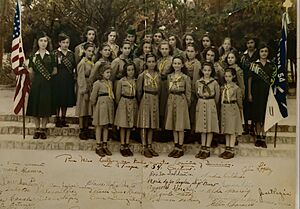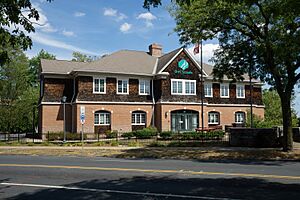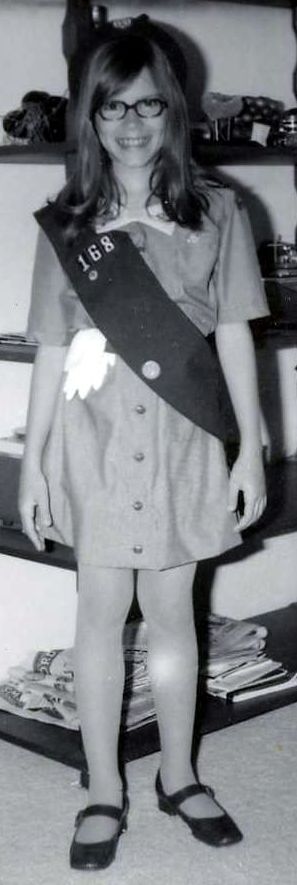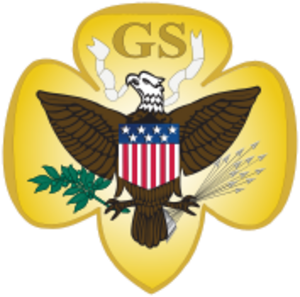Girl Scouts of the USA facts for kids
Quick facts for kids Girl Scouts of the United States of America |
|||
|---|---|---|---|

The current Girl Scouts logo, introduced in 2009.
|
|||
| Headquarters | New York City, U.S. | ||
| Country | United States | ||
| Coordinates | 40°45′3″N 73°59′0″W / 40.75083°N 73.98333°W | ||
| Founded | March 12, 1912 | ||
| Founder | Juliette Gordon Low | ||
| Membership |
|
||
| CEO | Bonnie Barczykowski | ||
| Affiliation | World Association of Girl Guides and Girl Scouts | ||
|
|
|||

Girl Scouts of the United States of America (GSUSA), often called Girl Scouts, is a group for girls in the United States and for American girls living in other countries. It was started by Juliette Gordon Low in 1912. She met Robert Baden-Powell, who founded Scouting (formerly Boy Scouts), a year before starting Girl Scouts.
The main goal of Girl Scouts is to help girls become brave, confident, and good people who make the world better. They do this through activities like camping, helping their community, and learning useful skills such as first aid. Girls can earn badges by finishing tasks and learning new skills. Older members can earn special awards like the Bronze, Silver, and Gold Awards. Members are grouped by their grade level, and activities are made for each group. Girl Scouts is also part of a bigger worldwide group called the World Association of Girl Guides and Girl Scouts (WAGGGS).
Contents
The Story of Girl Scouts
How Girl Scouts Began
Girl Scouting in the United States started on March 12, 1912. This is when Juliette Gordon Low held the first Girl Guide meeting in Savannah, Georgia. Since then, it has grown to have millions of members. From the very beginning, Girl Scouts has always been just for girls.
Juliette Gordon Low's grandmother wrote a book about her experiences on the frontier. Juliette used some of these stories to create traditions for Girl Scouts. In the early days, Juliette Low tried to join with other groups like Camp Fire Girls, but it didn't work out.
Girl Scouts Grows and Changes
In 1913, the group changed its name to Girl Scouts of the United States. Its main office moved to Washington, D.C.. In 1915, the organization became official and moved its main office to New York City. The name changed one last time in 1947 to Girl Scouts of the United States of America. In 1950, the U.S. Congress officially recognized the organization.
By 1920, there were almost 70,000 members. By 1930, this number grew to over 200,000. As of 2013, there were over 3.2 million Girl Scouts, including both young members and adults. More than 50 million American women have been Girl Scouts over the years.
Girl Scouts are organized into groups called patrols and troops. These troops are part of larger local councils. Today, there are 111 councils across the United States. The Juliette Gordon Low Historic District in Savannah, Georgia, became a national Girl Scout center in 1956. Juliette Low left her carriage house to the local Savannah Girl Scouts when she passed away in 1927. This building became the first Girl Scout Headquarters.
Becoming More Inclusive
In the past, many Girl Scout groups were separated by race because of laws and customs. The first troop for African American girls started in 1917. The first troop for American Indian girls was formed in New York in 1921. The first troop for Mexican Americans was created in Houston, Texas, in 1922.
By the 1950s, Girl Scouts started working hard to end racial separation in their camps and groups. Martin Luther King Jr. even called Girl Scouts "a force for desegregation" in 1956. In 1969, a program called Action 70 was started to help stop prejudice. In 1975, Gloria D. Scott, an African American woman, became the national president of Girl Scouts.
Wing Scouts: Flying High
The Wing Scouts was a special program for older Girl Scouts who were interested in aviation (flying). It began in 1941 and continued into the 1970s. Wing Scouts learned about planes and even got to take courtesy flights. For many girls, this was their first time flying. Some Senior Girl Scouts who had been in the program for three years even got to briefly control a small plane during a flight. The program ended when United Airlines faced money problems in the 1970s.
Girl Scout Age Levels
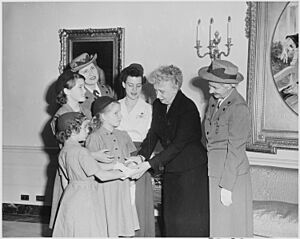
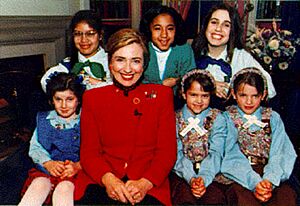
Girl Scouts has different age levels, each with activities designed for girls at that stage. The levels have changed over the years.
As of 2024, girls can join Girl Scouts from kindergarten all the way through 12th grade. The current age levels are:
- Daisies: Kindergarten and 1st grade
- Brownies: 2nd and 3rd grade
- Juniors: 4th and 5th grade
- Cadettes: 6th through 8th grade
- Seniors: 9th and 10th grade
- Ambassadors: 11th and 12th grade
Most girls join a troop, but if there isn't a troop nearby, or if a girl prefers, she can join as an individual Girl Scout. These individual members were once called "Juliettes" and are now known as "Independent Girl Scouts." They can still do activities and earn badges on their own.
Mariner Scouts: Water Adventures
The Mariner Girl Scout program started in 1934 for older Girl Scouts who loved water activities. It was similar to the Boy Scouts' Sea Scouting program. Mariner Scouts learned about boating and other water-based skills. This program is still active today, but it's smaller, as many girls now join Sea Scouting, which has included both boys and girls since 1971.
Special Programs for All Girls
Girl Scouts also has special programs for girls who might have a harder time joining regular troops. For example, the "Beyond Bars program" helps daughters of mothers who are in prison connect with their moms through Girl Scout activities. There are also programs for girls in detention centers, girls in rural areas, girls living in public housing, and American girls living overseas. These programs make sure that all girls can be part of Girl Scouting.
How Girl Scouts is Organized
The national Girl Scout organization has its main office in New York City. It is led by a chief executive officer (CEO) and a board of directors. Bonnie Barczykowski is the current CEO, and Noorain Khan is the president of the board of directors.
Below the national leadership are local councils. These councils usually cover a large part of a state or a specific area. Councils often own and run camps for the troops in their region. Councils are then divided into smaller areas, like neighborhoods or service units, which include troops of all age levels in a smaller town or community.
The smallest group is the troop. A troop can have as few as 5 girls or more than 30. Troops might also be divided into smaller groups called patrols.
Girl Scout Symbols and Traditions
Promise, Law, Motto, and Slogan
The Girl Scout Promise The Girl Scout Promise is a special pledge that girls say. It can be said in English, Spanish, or American Sign Language. It means the same thing in all languages:
On my honor, I will try:
To serve God* and my country,
To help people at all times,
And to live by the Girl Scout Law
* Members may substitute for the word God
in accordance with their own spiritual beliefs.
When saying the Promise, Girl Scouts often hold up their three middle fingers on their right hand to make the Girl Scout sign. Girl Scouts believes that each person can understand the word "God" in their own way, based on their personal beliefs. Girls can use a different word that fits their beliefs, like "Creator," "my faith," or "Allah." Many Girl Scouts also use "Community" or "Good."
The Girl Scout Law The Girl Scout Law is a set of rules that guides how Girl Scouts act. The current version is:
I will do my best to be
honest and fair,
friendly and helpful,
considerate and caring,
courageous and strong, and
responsible for what I say and do,
and to
respect myself and others,
respect authority,
use resources wisely,
make the world a better place, and
be a sister to every Girl Scout.
The Girl Scout Law has changed a few times since it was first written in 1912 by Juliette Gordon Low.
Motto Be prepared.
Slogan Do a good turn daily.
Girl Scout Uniforms
Girl Scout uniforms have changed a lot over the years. They started as navy blue in 1912, then became khaki in 1914, and later the familiar green. Since 2008, girls at each level have a required part of their uniform (like a tunic, sash, or vest) where they display their official pins and awards. They wear this for ceremonies or when they officially represent Girl Scouts.
For girls aged 5 to 14, the main part of the uniform is a tunic, vest, or sash. They wear this with their own solid white shirts and khaki pants or skirts. High school Girl Scouts can also wear a scarf that connects them to Girl Scouts around the world. Adult members wear a Girl Scout scarf or tie with their own navy-blue business clothes.
Earned awards go on the front of the vest or sash. Fun patches can be put on the back. Daisies wear blue vests, Brownies wear brown vests, and Juniors wear green vests. Cadettes, Seniors, and Ambassadors wear khaki vests.
Logos
The first Girl Scout emblem was designed by Juliette Gordon Low and was used for many years. The current Girl Scouts of the USA logo is a modern version of a design from 1978 by graphic designer Saul Bass. In 2010, the hair and facial styles in the logo were updated.
Activities and Programs
One of the main things Girl Scouts do is go camping and enjoy outdoor activities like canoeing or backpacking. Troops also do service projects, such as flag ceremonies, collecting food for food drives, visiting nursing homes, and singing carols. Troops can also plan trips within the United States or even to other countries. They might also organize learning events like first-aid training or going to a play. The most well-known Girl Scout activity is probably the yearly sale of Girl Scout Cookies, which started in 1917 to help troops and councils earn money.
Girl Scouts and STEM
Girl Scouts has many programs and badges related to STEM. These programs encourage girls to be interested in STEM fields. The first STEM-related badges, like Electrician and Flyer, were available in 1913. Computer-related badges appeared in the 1980s.
In 2012, a study showed that 74% of teenage girls were interested in STEM subjects, but only 25% of STEM jobs were held by women. Because of this, Girl Scouts has made a big effort to add more STEM programs. They have partnered with groups like NASA, AT&T, and Lockheed Martin. NASA even worked with Girl Scouts to create a 5-year space education program called "Reaching for the Stars: NASA Science for Girl Scouts."
Girl Scouts also has several FIRST Robotics Competition teams, like the Space Cookies Team 1868. These teams are all-girl and work to get more girls involved in STEM. The Space Cookies were the first all-girls team to reach the finals at the FRC world championships. They also helped start the Girl Scout STEM Pledge, which aims to get millions of girls into STEM fields.
Girl Scouts currently offers 127 badges and journeys in the STEM category. In 2020, they added 24 new badges in STEM, business, and leadership.
International Travel and Events
Every three years, Girl Scouts holds a big international convention. Here, they vote on rules and have guest speakers and activities for thousands of girls and former Girl Scouts. The most recent convention was held in 2023 at Walt Disney World in Florida.
Destinations are special travel opportunities for older Girl Scouts. These trips can be within the United States or in other countries. Destinations often focus on international experiences, outdoor adventures, science, meeting new people, or learning about careers, like learning about working for NASA.
A "Destination" might also be a trip to one of the WAGGGS World Centers, which are special places for Girl Guides and Girl Scouts around the world:
- Our Cabaña in Cuernavaca, Mexico
- Our Chalet in Adelboden, Switzerland
- Pax Lodge in London, England
- Sangam World Centre in Pune, India
- Kusafiri in Africa
Girl Scout Traditions
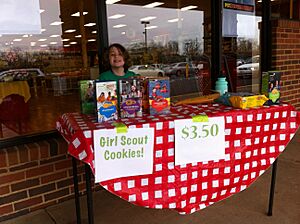

Girl Scouts of the USA has many special customs and traditions. These include camping, helping the community, singing, and earning money to support their activities. The Girl Scout Handshake and the Girl Scout signal for silence are traditions shared by all WAGGGS member organizations. Other traditions include the Friendship Circle with "the squeeze," using bandanas and homemade sit-upons on camping trips, and the buddy system.
Bridging is a ceremony where girls move from one Girl Scout level to the next. Girls walk across a bridge to their new level and are greeted with the Girl Scout Handshake. A famous bridging ceremony happens in San Francisco, where Girl Scout Juniors become Cadettes by crossing the Golden Gate Bridge.
World Thinking Day and "Girl Scouts' Own" are traditions celebrated by Girl Scouts and Girl Guides worldwide. World Thinking Day happens every year on February 22. This day is special because it's the birthday of both Robert Baden-Powell and Olave Baden-Powell, who were important leaders in Scouting. On this day, Girl Scouts around the world think about their fellow Girl Scouts in other countries. Local groups often have celebrations where troops share information about the culture and customs of a country they choose. Many Girl Scouts in America also celebrate Juliette Gordon Low's birthday on October 31, which is called Founder's Day. These parties often include girls dressing up in Halloween costumes and having birthday cake.
A "Girl Scouts' Own" is a special ceremony where girls think about what Girl Scouting means to them and the world around them. It's a quiet time for Girl Scouts to create a special moment of their own. It can be held at any time and include just one troop or many troops together.
Badges and Awards
All Girl Scout levels can earn badges. Each level has specific badges they can earn, and they are shaped differently:
- Daisies earn flower-shaped badges.
- Brownies earn triangle-shaped badges.
- Juniors earn circle-shaped badges.
- Cadettes earn diamond-shaped badges.
- Seniors earn rectangle-shaped badges.
- Ambassadors earn square-shaped badges.
Earned Badges and Awards are worn on the front of a Girl Scout's vest or sash. Fun Patches are worn on the back. Daisies wear blue vests, Brownies wear brown vests, and Juniors wear green vests. Cadettes, Seniors, and Ambassadors wear khaki vests.
Journey Awards
Each Girl Scout level has several Journey programs. A Journey is a series of lessons on a specific topic. Girls must complete all parts of a Journey to earn it. If a Girl Scout completes three Journeys at one level, she earns a Summit Pin. Before starting work on a Bronze, Silver, or Gold Award project, a Girl Scout must complete at least one Journey for her level.
Other Awards
Girl Scouts can earn other awards, usually pins, like the Leadership Torch, Community Service Bar, and World Thinking Day Award. They can also earn awards from other groups, such as religious emblems or the President's Volunteer Service Award.
Highest Awards
The highest awards in Girl Scouting are the Bronze, Silver, and Gold Awards. These awards require girls to complete large service projects that show leadership and help their community.
- The Girl Scout Gold Award is the highest honor a Girl Scout can earn. It is for Girl Scout Seniors and Ambassadors. This award shows a Girl Scout's strong dedication to Girl Scouting and her community. Earning the Gold Award takes hard work and a willingness to take on big responsibilities. The Gold Award project takes at least 80 hours to complete.
- The Girl Scout Silver Award is the highest honor a Girl Scout Cadette can earn. It gives girls a chance to do great things and make their community better. The Silver Award project takes at least 50 hours to complete.
- The Girl Scout Bronze Award is the highest honor a Girl Scout Junior can earn. It teaches girls leadership and planning skills to complete a project that helps their community. The Bronze Award project takes at least 20 hours to complete.
Adult Recognition
There are also awards for adult Girl Scout volunteers, such as the Outstanding Volunteer, Appreciation Pin, and Thanks Badge. These awards recognize adults who go above and beyond in helping Girl Scouts.
Girl Scouts' Impact on American Life
Many famous American women were once Girl Scouts, including Taylor Swift, Sonia Sotomayor, Dakota Fanning, Lucille Ball, Katie Couric, and Nancy Reagan. Many former Girl Scouts have become successful leaders in fields like law, medicine, politics, and science. Since Lou Henry Hoover, the wife of a U.S. President, the current First Lady has served as the honorary president of Girl Scouts.
During World War I and World War II, Girl Scouts helped the country by selling defense bonds, growing victory gardens, and collecting waste materials. They also helped their communities through service projects like soup kitchens and food drives.
Over twenty of NASA's female astronauts were former Girl Scouts. The first American woman to walk in space, Dr. Kathryn Sullivan, was a former Girl Scout.
The American Girl Magazine
Girl Scouts published its own magazine from 1917 to 1979. It was first called The Rally and then The American Girl. At its peak in 1949, over 510,000 copies were printed each month.
Girl Scout Senior Roundups
International Girl Scout gatherings called Senior Roundups were held every three years from 1956 to 1965. These large events brought together thousands of girls from different places.
- Milford, Michigan (1956) had 5,000 girls.
- Colorado Springs, Colorado (1959) had 10,000 girls.
- Button Bay, Vermont (1962) had 9,000 girls.
- Farragut Reservation, Idaho (1965) had 12,000 girls.
Important Discussions
Religion and Inclusivity
When Girl Scouts first started, it was meant to be open to everyone, no matter their religion. Since 1993, Girl Scouts have been able to use a word or phrase that fits their own beliefs instead of "God" in the Girl Scout Promise. This means that if a girl's spiritual beliefs are different, she can say something like "my faith" or "the Creator." This policy helps make sure that all girls feel welcome and included in Girl Scouting, while still keeping the idea of a spiritual foundation.
Girl Scouts does not tell troops whether they must or must not pray. The decision to say a prayer or blessing is made by the local troop or group, and it should be respectful of everyone's beliefs.
Girl Scouts also has an optional "My Promise, My Faith" pin that girls can earn. Girls can also participate in religious recognition programs created by their own religious organizations and wear those emblems on their uniform.
Welcoming All Girls
Girl Scouts of the USA believes in respecting the values and beliefs of all its members. The organization welcomes all girls. In 2011, the Girl Scouts of Colorado council stated that if a child identifies as a girl and her family presents her as a girl, she is welcome as a Girl Scout. In 2015, the Girl Scouts of Western Washington returned a large donation because the donor said the money could not be used to support services for transgender Girl Scouts. The council then raised even more money online to make up for it. Girl Scouts has always aimed to be an inclusive organization for girls from all backgrounds.
The Radical Monarchs
In 2014, a community group for girls of color called the Radical Brownies was started in Oakland, California. It was created to help empower girls of color and build strong community bonds. The group's members, aged 8–12, could earn badges in topics like "radical beauty" and "food justice."
In 2015, the Radical Brownies changed their name to the Radical Monarchs. This change happened after Girl Scouts of the USA explained that the original name and uniforms caused some confusion with their own organization. The Radical Monarchs continue their mission to empower young girls of color.
100th Anniversary Celebration
Girl Scouts of the USA celebrated its 100th anniversary in 2012. Many events took place across the country to mark this special occasion.
- The Girl Scouts had a float in the famous Pasadena, California Tournament of Roses Parade in 2012. Girl Scouts designed and decorated the float themselves.
- US President Barack Obama signed a law to create special silver dollar coins to honor the 100th Anniversary of Girl Scouts.
- The Girl Scouts of Minnesota and Wisconsin River Valleys hosted "The Great Girl Gathering" for 140,000 girls at the Mall of America in Bloomington, Minnesota.
- The Girl Scout Council of the Nation's Capital in Washington, DC, held a huge "Girl Scouts Rock the Mall: 100th Anniversary Sing-Along" on the National Mall. Over 200,000 people attended.
- Girl Scouts of Citrus partnered with Walt Disney World for a special bridging event at Epcot.
- Girl Scouts also introduced a new cookie called Savannah Smiles to celebrate the anniversary.
- In Savannah, Georgia, where Girl Scouting began, there was a "Party in the Park" and a "Sunrise Service." The city also dedicated its annual "Georgia Day" to Juliette Gordon Low.
Similar Organizations
Camp Fire was founded in 1910, two years before Girl Scouts. It became a co-educational group in 1975, welcoming both boys and girls.
Some religious groups have their own youth clubs for girls, such as Mpact Girls (for the Assemblies of God) and Little Flowers Girls' Club (Catholic-focused). American Heritage Girls (AHG) is a Christian organization started in 1995 by parents who wanted a Christian alternative to Girl Scouts. AHG focuses on building "women of integrity through service to God, family, community and country."
|
See also
 In Spanish: Girl Scouts of the USA para niños
In Spanish: Girl Scouts of the USA para niños




